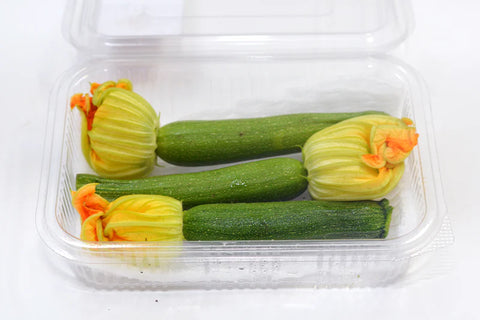
Rs. 230.00
Baby Green zucchini blossoms are fragile, yet as long as they are attached to the fruit of the plant, the fruit will extend the blossom's shelf-life. The tissue paper thin blossoms are faintly fuzzed, light weight and once mature their broad and pointed flower petals will close inward.Not Available at present - Rs. 200.00
Broccoli is from the same family of cabbage and cauliflower, so can be substituted in many Indian dishes that phool gobi and patta gobi are used in.
Rs. 350.00
These small green orbs are members of the cabbage family with the same ability to be enjoyed raw in salads or slaws or turned into tender, caramelized nuggets of goodness when cooked. But before you get to cooking them, you need to prep them.
Rs. 160.00
The true scallion. Not a spring onion which is what most cooks in India commonly use when the recipe requires scallions. Milder in taste. Also called bunching onions in some parts of the world.
Bunching onions are a scallion and never form a bulb and have hollow leaves. The leaves are prized when cooking unlike the more difficult leaves of the spring onion. Other names for Bunching Onion are Welsh Onion and Long Green Onion.
Both the white and the green parts are used in recipes and eaten both raw and cooked. These fresh young onions are identified by their slender shape and mild flavor. The white stalk has the same sharp, onion taste though with less bite, while the dark green leaves have a fresher, grassy milder flavor.
A popular ingredient in Asian cuisine, especially in East and Southeast Asia. It is particularly important in China, Japan, and Korea, even more than the bulb onion so common elsewhere. In the West, bunching onion is primarily used as a scallion or salad onion.
Scallions are mild enough that both the whites and the greens can be eaten raw, as in scallion salad, a popular side dish for Korean barbecue, or as a crunchy garnish for soups, and chili, and potato puree. Raw scallion whites and greens can be pickled whole or fermented in kimchi. Whole scallions are delicious grilled or roasted—the leaves become charred and the the whites tender and sweet.
Many stir-fry recipes call for separating the whites and the greens. This method mellows out the sharp flavor of the bulb, while allowing the raw greens to stay fresh as a garnish. An added bonus? The scallion whites are usually the first ingredient in the wok, infusing the cooking oil with their aromatics and flavoring the rest of the stir-fry.

Not Available at present - Rs. 110.00
he color of bell peppers changes from green to yellow, orange, and red the longer it is allowed to mature on the plant. Green peppers feature a more bitter flavor profile, while the orange and yellow bell peppers are sweeter, with the sweetest being the red bell pepper.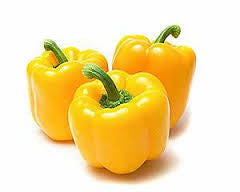
Not Available at present - Rs. 110.00
The color of bell peppers changes from green to yellow, orange, and red the longer it is allowed to mature on the plant. Green peppers feature a more bitter flavor profile, while the yellow bell peppers are sweeter.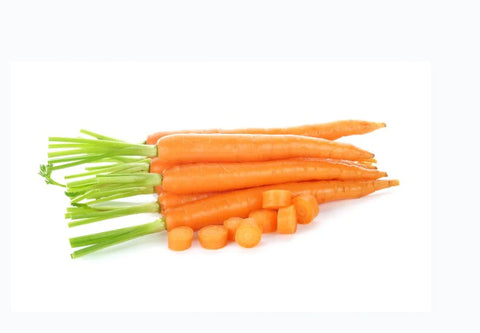
Rs. 120.00
A special variety more tender and sweet than regular carrots. All taste no core. Use whole for maximum appeal.
Rs. 220.00
Celeriac, also called turnip-rooted celery or knob celery, is a variety of celery cultivated for its edible roots. It is sometimes called celery root. Beautiful in soup, sliced into salads or as a mash after roasting. Try it in big-flavoured, slow-cook dishes, or in its classic form, and as they do in France, as a remoulade.
Rs. 180.00
Enjoy celery raw. Both the stalks and the leaves are edible. Remove the stringy parts if you find that the stalks are too tough.
Rs. 340.00
Carrots were originally purple, red, white, green, yellow, or black. They were bred by taking the red and yellow carrots to create the orange root, just like using a paint box. So the orange carrot is actually the new kid on the block.
Deep red, bright yellow in color, they don't look like your typical orange carrot. Great colours with rich flavour and sweetness. A great way to dress up a roast, grill or a salad.
Another plus — kids tend to be a bit more adventurous and anything that helps children to enjoy vegetables more shouldn’t be ignored.

Not Available at present - Rs. 670.00
Please note that the price mentioned below is the kg price. Typically, a head of Green cauliflower weighs between 600 - 900 grams.
Not Available at present - Rs. 670.00
The orange or "cheddar" cauliflower tastes slightly more sugary and creamier than its normal white cousin, but it can be successfully used in any recipe that calls for cauliflower. It's great when mashed, sauteed with potatoes, used as the base for soups, or roasted.
Its flavor is mild, slightly sweet, and creamy. Delicious pureed in soup! Roasting is a popular thing to do with cauliflower – although it is rather nice raw, sliced into salads. Serve with dip on a vegetable tray. Or steamed and covered in cheese sauce or melted butter. Cauliflower can be interchanged for broccoli in most recipes.
Happily, orange cauliflower will hold its color no matter how (or how long) you cook it.
Please note that the price mentioned below is the kg price. Typically, a head of Orange cauliflower weighs between 600 - 900 grams.

Not Available at present - Rs. 670.00
Purple cauliflower: it’s intriguing, alluring, and powerful.
Roasting cauliflower lightly caramelizes the sugars in the vegetable. It brings the sweetness, savoriness, and nuttiness out of the cauliflower. Simply toss the cauliflower in some olive oil, season it with salt and pepper and roast it in the oven. Its a super easy side dish that brightens any dinner table and is sure to bring excitement and lively dinner conversation.
Purple cauliflower is said to taste nuttier and sweeter than white cauliflower and does not have the slight bitterness sometimes found in white cauliflower. You can usually steam, simmer and roast purple cauliflower and it will retain its color. Serious overcooking will wash out some of the brightness of the colour.
Purple cauliflower lets you add a vibrant color to a party vegetable dip, salad or vegetable roast.
The purple color is natural. It is the antioxidant anthocyanin that gives it the purple pigment.
Please note that the price mentioned below is the kg price. Typically, a head of Purple cauliflower weighs between 600 - 900 grams.

Rs. 110.00
Kirby cucumbers are usually short and always bumpy. Kirbys are nice and crunchy for eating raw, and are eaten with the dark green skin. They are flavourful enough to be perfect for pickling too.
Rs. 340.00
Edamame are immature green soyabeans that are often served as an appetizer. In Japan and China edamame is a common snack like eating roasted peanuts is for us. A great protein snack for a party which is the perfect combination of sweet and salty. Edamame is not only delicious to snack on but also packed with a nutritional punch. Like most beans, soybeans are sweeter and have more umami before they are fully mature.
Add the fresh edamame to salted water (5 grams salt in 450 ml water) once it reaches a boil for ten minutes, and then remove from heat and refreshed in ice-cold water to keep their bright green colour. Sprinkle salt before serving.
This has worked well for us but the length of time will depend on personal choice a lot, since some like the inner bean to only be minimally cooked and have some bite while others prefer it melting soft. Also the amount of salt is something you will have to adjust to your taste. So start testing them around six minutes into the boil.
The pods can also be steamed, microwaved or shallow fried if you prefer. The beans can then be extracted from the pods after cooking.You can quick blanch edamame and pan fry them seasoning with soy sauce and some hot pepper. You can also toss the shelled edamame into your salads or fried rice.
Cook just enough that the pods should easily release the beans from the outer skin when you pull the pod between your front teeth, but avoid overcooking where the outer skin begins to disintegrate.
Soybeans are highly nutritious, and they often become a cornerstone of plant-based diets thanks to their high protein levels. Indeed, about 15 per cent of the bean is protein. They also contain all nine of the essential amino acids, and are one of the only vegetables to do so.
Takes more work but if you cut and trim off both ends of the pods, the salt water will season the soybeans inside the pods when boiling.

Rs. 730.00
No, it is not necessary to defrost frozen edamame.
Add edamame pods (frozen) to the boiling salted water and cook, stirring once in a while, for 4–5 minutes, or until the soybeans are an al dente consistency.
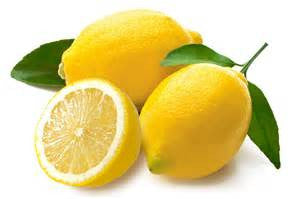
Rs. 190.00
Eureka lemons have a bright citrus flavor that is very tart owing to the fruit's acidity. The juice is frequently sweetened with sugar or added in small quantities to dishes to lend a fresh tartness.
They are oblong shaped and noticeably larger in size with bright, textured, sunny thick skin and juicy, yellow flesh. The rind is full of volatile oils, providing an intense citrus aroma. Eureka lemons have a pronounced blossom-end knob.
Eureka offers a tart and acidic flavour. It is moderately sweet, but is known for a tang that can make your mouth pucker.
Eureka lemons may be used in wide range of applications, from sweet to savory. They can be made into marmalades or used in baked goods, such as lemon meringue pie, and their zest can be infused into oils. Both its zest and juice can be used in cocktails, syrups, marinades, and dressings. Pair with other citrus, tea, or fresh fruits and vegetables. Their slices or wedges can be used as a garnish.
The zest from the outer peel has a fragrant lemon flavor that lacks tartness or sweetness. The white pith, between the outer peel and juicy flesh, is dry and bitter.
Note: Images are only for illustrative purposes, actual product and colour may slightly differ.
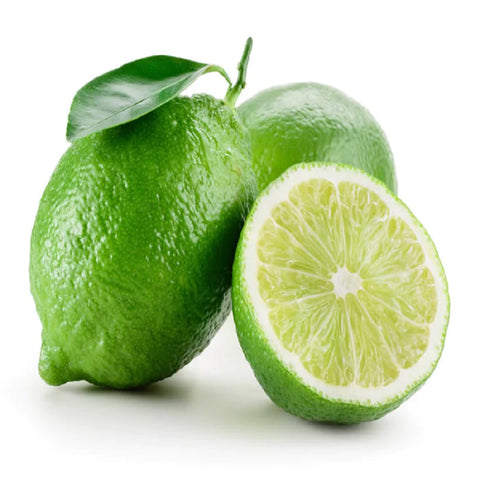
Rs. 170.00
Eureka lemons have a bright citrus flavor that is very tart owing to the fruit's acidity. The juice is frequently sweetened with sugar or added in small quantities to dishes to lend a fresh tartness.
They are oblong shaped and noticeably larger in size with bright, textured, sunny thick skin and juicy, yellow flesh. The rind is full of volatile oils, providing an intense citrus aroma. Eureka lemons have a pronounced blossom-end knob.
Eureka offers a tart and acidic flavour. It is moderately sweet, but is known for a tang that can make your mouth pucker.
Eureka lemons may be used in wide range of applications, from sweet to savory. They can be made into marmalades or used in baked goods, such as lemon meringue pie, and their zest can be infused into oils. Both its zest and juice can be used in cocktails, syrups, marinades, and dressings. Pair with other citrus, tea, or fresh fruits and vegetables. Their slices or wedges can be used as a garnish.
The zest from the outer peel has a fragrant lemon flavor that lacks tartness or sweetness. The white pith, between the outer peel and juicy flesh, is dry and bitter.
.

Rs. 160.00
The Fennel bulb is from the same plant that gives us Saunf seeds that we Indians eat after meals. It is native to the Mediterranean and the bulb is eaten both raw and cooked in a variety of cuisines, most famously Italian food.
The bulb of the fennel plant can be prepared and eaten as a vegetable and is braised, grilled, sauteed or sliced thinly and served in salads. Fennel is a wonderfully versatile vegetable which resembles a peeled onion bulb that someone has pressed between their hands so its no longer round.
It has the cool crunch of celery with a strong note of licorice when you take a bite. The flavour is similar to anise or tarragon. It is lovely sliced thin and served with Parmesan in a salad, luscious and filling in a cheesy gratin, and absolutely delicious roasted.
Roasted, fennel caramelizes at the edges and loses its crunch. The licorice notes that were so discernible when the fennel was raw leave only a hint when roasted but gaining a little sweetness. Even people who run from anything licorice flavoured, easily enjoy fennel when it is warm and roasted.
If you are serving fennel raw, it's best sliced very thin; a mandoline comes in handy here. Slices of the bulb can also be pickled and eaten as a snack.
Note: Images are only for illustrative purposes, actual product and colour may slightly differ.

Not Available at present - Rs. 220.00
Artichoke flesh is nutty, verdant, and a little sweet — with a flavour reminiscent of fresh corn.
You can boil, grill, braise, or stuff and bake artichokes. But my favorite way to cook artichokes, and the easiest way to cook them, is to steam them. The artichokes are done when a knife is inserted into the base and there is no resistance.
Whole steamed artichokes are a finger food. After cooking, You peel off a petal, then scrape off the tender portion at the tip with your teeth. Dip the ends of the leaves in lemon juice and melted butter if desired. The outermost layers tend to be the toughest, and the leaves get softer as you get closer to the center.
Be careful when you reach the purple leaves at the very center — they tend to be prickly, so use a kitchen towel to discard them. When you reach the choke (the fuzzy bit), scrape it off with a spoon or carefully slice it off, and discard. All that’s left now is the heart.
The heart is completely edible and amazingly delicious. The other parts of the artichoke -- the actual leaves, the hairy stuff at the bottom, the stem, etc. - are not eaten. The fuzzy choke is too fibrous to eat in regular artichokes, but edible in baby artichokes.
Artichokes may be eaten cold or hot, but I think they are much better hot. They are served with a dip, either melted butter or mayonnaise.
They can also be barbecued or grilled: cut in half lengthwise, remove the choke, brush with olive oil and grill for 30 minutes, until tender.
A good guide on cleaning and trimming artichokes is at https://www.finecooking.com/article/how-to-clean-and-trim-artichokes-for-recipes

Rs. 150.00
The easiest way to use horseradish is to simply shave off the brown peel and shred or grate some fresh horseradish to serve as a flavoring for hearty soups or stews. Shred as close to serving time as possible, since horseradish turns bitter and discolors within a few hours.
The volatile mustard-like oil in horseradish brings tears to the eyes and heat to the tongue. Horseradish is at its best and most flavorful when freshly grated.
In cooked dishes, horseradish is added at the end of cooking as heat eliminates both the root's aroma and zing.

Rs. 280.00
Pronounced hala-pee-nyo, it is a mildly hot pepper, and an indispensable ingredient in Mexican cuisine.
Thickly fleshed with a fresh flavor. Use in sandwiches, salsas or as a topping on pizzas. great starter when stuffed with cheese and roasted.
Note: Images are only for illustrative purposes, actual product and colour may slightly differ.